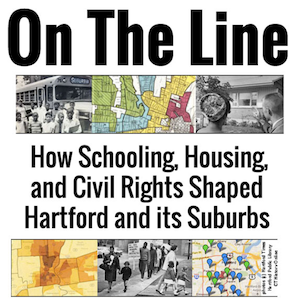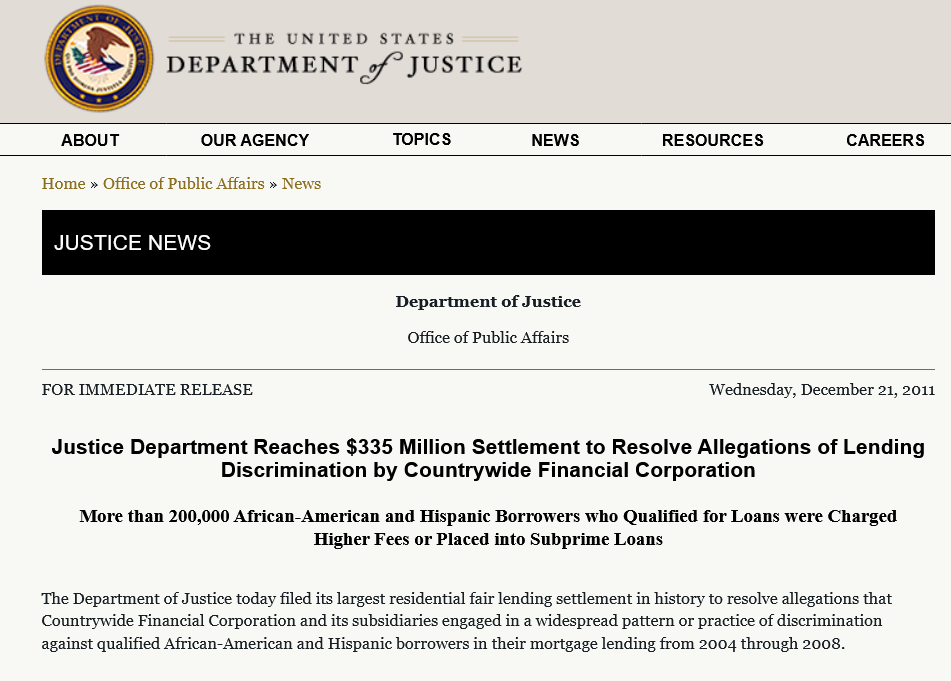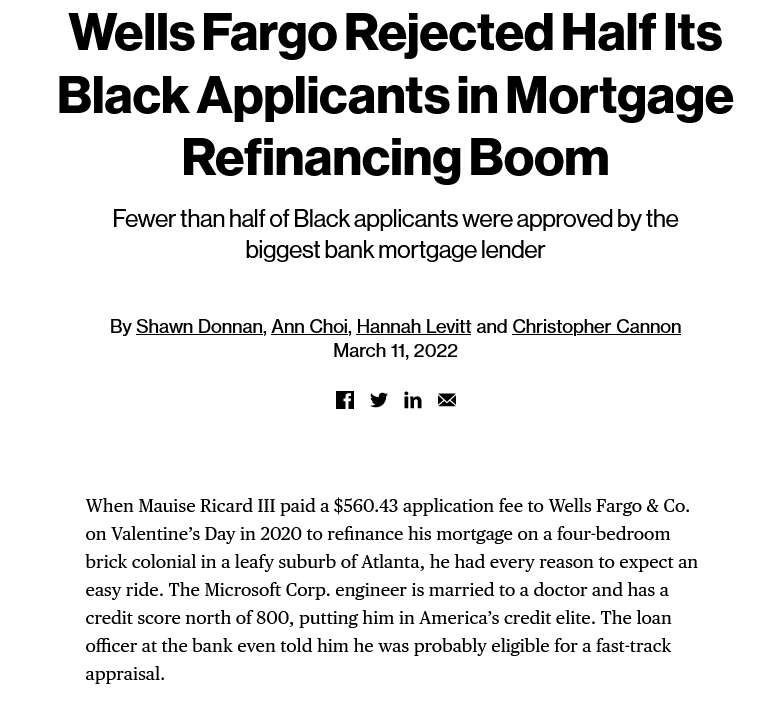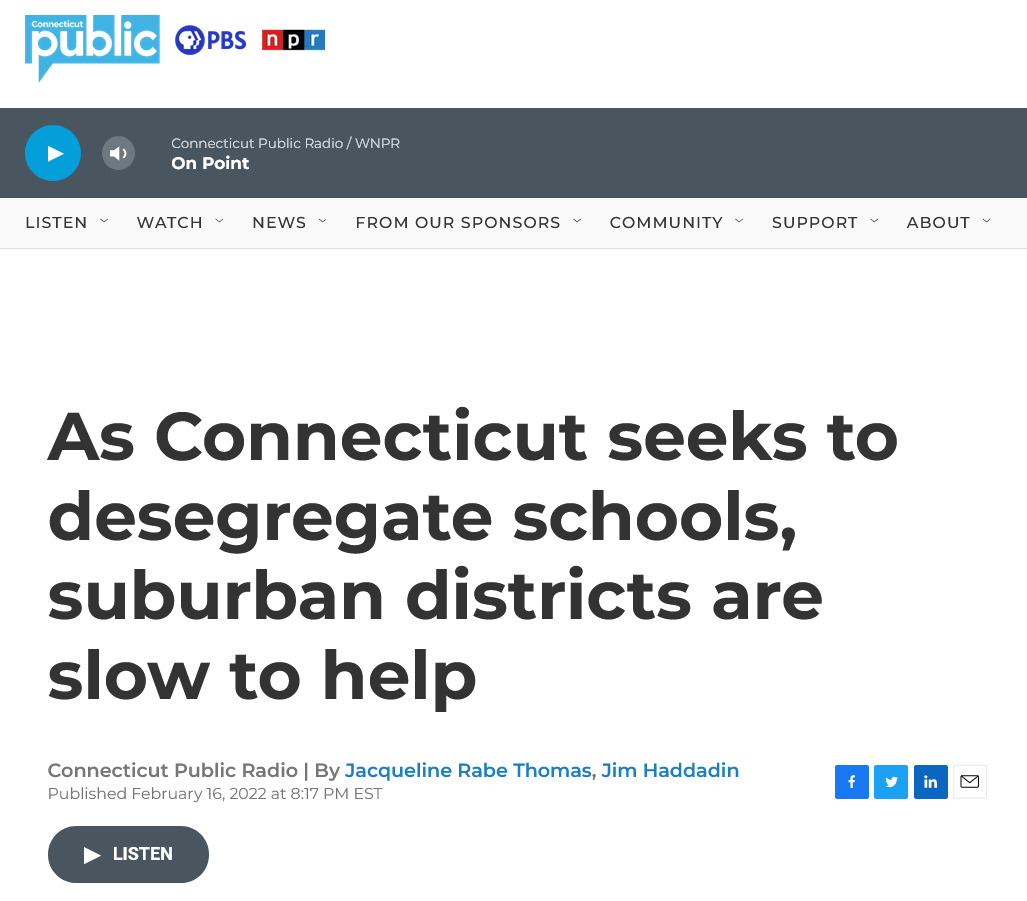Shannon Andros
Norwich Free Academy
TEACHER'S SNAPSHOT
Subjects:
African Americans, Civil Rights, Economics, Education, Rights & Responsibilities of Citizens
Course Topics/Big Ideas:
Rights and Responsibilities of Citizens, Role of Connecticut in U.S. History, The Struggle for Freedom, Equality, and Social Justice
Grade:
High School
Lesson Plan Notes
In 1934, the Federal Housing Administration (FHA), established in the wake of the Great Depression, was created to stimulate the economy, facilitate home buying, and increase employment by boosting the construction industry. Although the FHA was created to insure mortgages of lower-income Americans, it furthered segregation efforts by refusing to insure mortgages in and near traditionally African American neighborhoods. This was a policy known as “redlining.”
At the same time, the FHA was subsidizing (offering financial support to) builders who were mass-producing entire subdivisions, often with the requirement that none of the homes be sold to African Americans (see The Color of Law: A Forgotten History of How Our Government Segregated America by Richard Rothstein). In the years that followed, the Supreme Court decision of Brown v. Board of Education (1954) declared segregation in public schools unconstitutional. Segregation legally ended with the passage of the Civil Rights Act in 1964. Although this timeline of events demonstrates how the practice of segregation became illegal, the recent 2020 settlement of Sheff v O’Neill reveals how much segregation is still ingrained in our society today.
ESSENTIAL QUESTION
SUPPORTING QUESTIONS
- How does where you live affect how you live and the resources you have access to?
- How do current segregation practices affect Connecticut residents?
- Using examples from the sources, in addition to your own schema, what are ways that community members are resisting, challenging, and overturning segregation practices?
ACTIVITY
Building Schema
1. Begin the class by initiating a think.pair.share with the following question: “What are signs of a good neighborhood vs. a bad neighborhood?”
2. Ask the follow-up question: “How can the conditions of the neighborhood we live in affect our educational opportunities?”
3. Students will watch the Sheff v O’Neill video (3 minutes) to guide their thinking.
Stations
1. Organize students in groups of 3-5 people.
2. Station A will be completed together as a class. First, discuss the definition of institutionalized discrimination. (Unfair practices that are a part of the structure of society and that have grown out of traditional, accepted behaviors.) Then, together, as a class watch, “Race, The House We Live In” (6:04).
3. Students will then explore each of the remaining stations and collaborate through discussion and using the source information to complete the graphic organizer.
4. Once students have had enough time to explore each station, ask students to select one person from their group to be the speaker. Assign each group a station that they will be in charge to share out for.
Closure
1. Wrap up the lesson with an exit ticket. Distribute a post-it or ask students to write their response on the back of the graphic organizer. Ask students to (a) respond to the question: “How do these discriminatory practices affect the lives of Connecticut residents?” or (b) ask students to write down one thing that they learned in class today that they think others should know about.
2. Have students then select their choice for “Taking the Lesson One Step Further.”
3. If time permits, students can share out their exit ticket responses.
OPPORTUNITIES FOR ASSESSMENT
- Share one of the sources with an adult in your life. Ask them to review the content and interview them for their feedback and thoughts on the article or video.
- Illustrate a timeline of important events showing the barriers, challenges, and successes that marginalized groups have overcome due to segregation practices.
- Write a letter to a policymaker that (a) discusses the problem of segregation in schools and (b) presents a plan or set of ideas to address these inequities.
RESOURCE TOOL KIT
Introduction

“Settlement reached in Sheff v. O’Neill.” WFSB 3,
Station A

“Race the House We Live In.” California Newsreel, September 24, 2010.
Station B

“Federal HOLC ‘Redlining’ in Hartford Area, CT, 1937” interactive map. Dougherty, J., & Contributors. On The Line: How Schooling, Housing, and Civil Rights Shaped Hartford and its Suburbs.
Station C

“Justice Department reaches $335 million settlement to resolve allegations of lending discrimination by Countrywide Financial Corporation.” The United States Department of Justice, March 23, 2022.
Station D

Donnan, S., Cannon, C., Choi, A., & Levitt, H. “Wells Fargo Rejected Half Its Black Applicants in Mortgage Refinancing Boom: Fewer than half of Black applicants were approved by the biggest bank mortgage lender.” Bloomberg.com, March 11, 2022.
Station E

Rabe Thomas, J., & Haddadin, J. “As Connecticut seeks to desegregate schools, suburban districts are slow to help.” Connecticut Public, February 18, 2022. Read or listen.
ADDITIONAL RESOURCES
Places to GO
Prudence Crandall Museum, Canterbury
Marian Anderson Studio, Danbury
Connecticut Museum of Culture and History, Hartford
Check out other places of interest @ creativefolk.com/travel/ct.html
Things To DO
Stay involved and connect with local activist groups in your area:
Write a letter to your local representatives to fund efforts for fair housing and to desegregate schools.
Read a book on the subject:
- The Color of Law: A Forgotten History of How Our Government Segregated America by Richard Rothstein
- At the Boundaries of Homeownership: Credit, Discrimination, and the American State by Dr. Chloe Thurston
- Race for Profit: How Banks and the Real Estate Industry Undermined Black Homeownership by Keeanga-Yamahtta Taylor
Explore Historical Resistance to Segregation:
- NAACP (The National Association for the Advancement of Colored People) was founded in 1909 by civil rights warriors W. E. B. Du Bois, Mary White Ovington, Moorfield Storey, and Ida B. Wells.
- World War I triggered the Great Migration, the movement of African Americans from the rural to urban South and onward to northern and midwestern cities, a process that over the next few decades fundamentally reshaped the African American role in American politics and culture. In the wake of the war, two new currents of activism joined the freedom struggle.
- The Marcus Garvey Movement promoted Black nationalism, emphasizing economic self-reliance. Meanwhile, Black and White leaders came together in new interracial initiatives to promote cooperation, communication, and better conditions.
- During the WWII, Black participation in the armed services and in the defense industry, coupled with an NAACP-led campaign that connected the fight against Nazi fascism with the battles against racism and segregation at home, laid the groundwork for an expansion of the freedom struggle in the postwar years.
- Buchanan v. Warley case, 1917 ruling, the U.S. Supreme Court declared a Louisville ordinance requiring housing segregation unconstitutional, effectively turning the tide on enshrining segregation into law.
Websites to VISIT
Desegregate Connecticut: A Brief History of Segregation
Museum of the City of New York online exhibition “Activist New York”
On The Line: How Schooling, Housing, and Civil Rights Shaped Hartford and its Suburbs
Articles to READ
ConnecticutHistory.org:
- “The Effects of ‘Redlining’ on the Hartford Metropolitan Region” by Shaun McGann
- “How Real Estate Practices Influenced the Hartford Region’s Demographic Makeup” by Nicole Sagullo
- “Race Restrictive Covenants in Property Deeds” by Mary Daly
“The Racist Architecture Of Homeownership: How Housing Segregation Has Persisted” by Ailsa Chang, Jonaki Mehta, Christopher Intagliata. NPR, published May 4, 2021. Read or listen.
“A fight over housing segregation is dividing one of America’s most liberal states: Who gets to live in Connecticut?” by Jerusalem Demsas. Vox, updated Mar 29, 2021.




